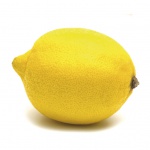 The lemon tree is a small tree (3-6 m high), perennial, of the Rutaceae family, with numerous branches provided with hard and thick thorns. The twigs are angular, rounded and smooth. The leaves are whole, coriaceous and persistent. They are green, although when they are young they can be reddish. The limb is largely elliptical, sharp and serrate-toothed. They measure 6-12.5 cm in length and 3-6 cm in width. The petiole is short and broadly winged. The flowers are hermaphroditic or functionally masculine.
The lemon tree is a small tree (3-6 m high), perennial, of the Rutaceae family, with numerous branches provided with hard and thick thorns. The twigs are angular, rounded and smooth. The leaves are whole, coriaceous and persistent. They are green, although when they are young they can be reddish. The limb is largely elliptical, sharp and serrate-toothed. They measure 6-12.5 cm in length and 3-6 cm in width. The petiole is short and broadly winged. The flowers are hermaphroditic or functionally masculine.
They can be solitary or arranged in axillary clusters. The petals are white on the top and purple on the bottom. Each flower has 20-40 stamens that form small groups.
The fruit is a fleshy hesperidium known as a lemon. Morphologically, in the hesperidium we differentiate three parts: the exocarp or epicarp, the mesocarp and the endocarp. In the exocarp there are carotenoids and flavonoids which give the fruit its characteristic colour. The exocarp is also full of depressed oil glands that give the fruit its characteristic smell. Immediately after the exocarp, the mesocarp is found. It is a white, thick and corky textured layer formed by long parenchymatous cells rich in pectins and hemicellulose. The combination of exocarp and mesocarp is called pericarp, more commonly known as peel or rind. The innermost portion is the endocarp or pulp. This portion is made up by many segments; Each segment is filled with vesicles that contain a sour juice.
The lemon seeds are oblong-ovoid and are found in the endocarp. The lemon has an oblong or oval shape and is chewed towards the ends. It measures between 7 and 12 cm in length, is of a light yellow or golden colour and has a very sour taste.
C.limonum is the citrus species most sensitive to the cold, since it is the most tropical, and it presents almost continuous flowering, requiring semitropical climates to vegetate. The most suitable climate for lemon cultivation is the Mediterranean-type, free of frost. The periods of drought followed by rainfall play an important role in flowering. They need permeable and soils low in limestone. It has seborregulatory properties, derived from the presence of flavonoids, citric acid, malic acid and vitamin C in its composition.
